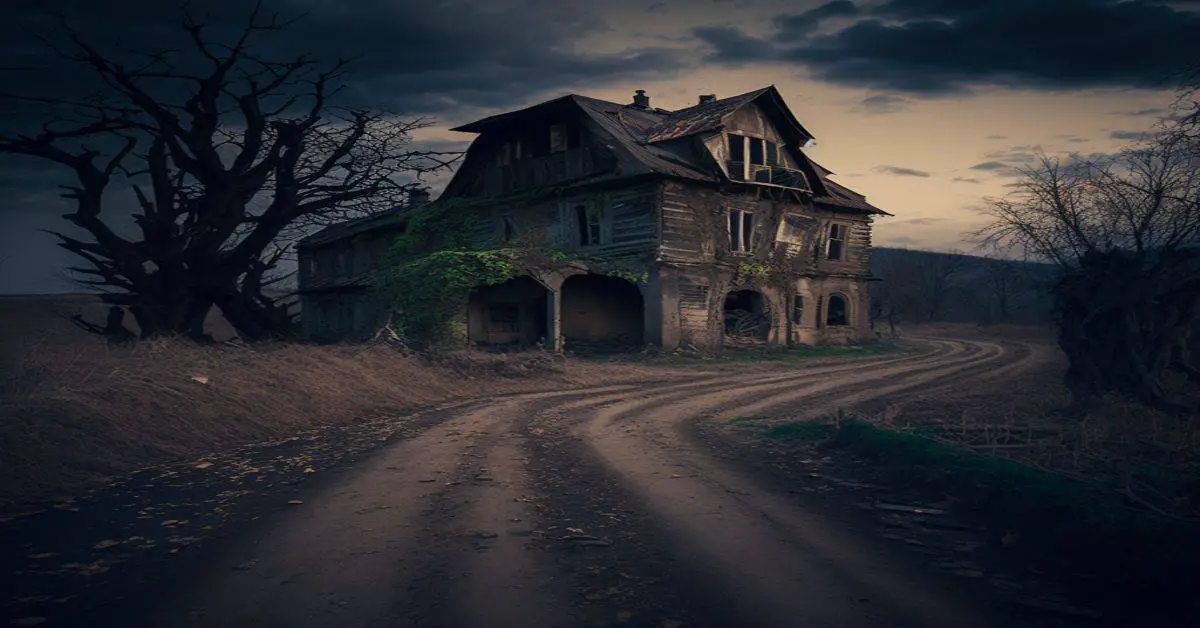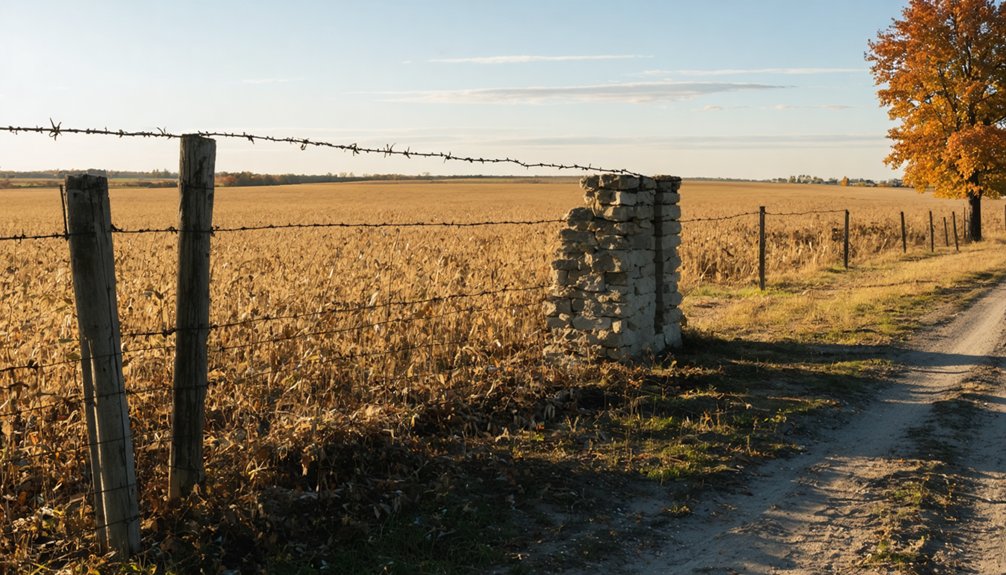You’ll find Lemmon’s remains at 39.5314414°N, -89.7942656°W in Sangamon County, Illinois, where this former canal town once thrived. The settlement emerged in 1833 along the Illinois & Michigan Canal route, drawing immigrants who built their lives around limestone quarrying and water trade. Today, only scattered concrete blocks and old railroad infrastructure peek through the dense forest, while dirt paths lead you to this historic site. The town’s fascinating blend of commerce, culture, and mysterious happenings awaits your discovery.
Key Takeaways
- Originally established in 1833 as Athens, Lemmon developed along the Illinois & Michigan Canal route during the mid-19th century.
- The town’s economy centered around limestone quarrying, with high-quality dolomite limestone discovered in 1850.
- Only remnants remain today, including two large concrete blocks and abandoned railroad infrastructure within dense deciduous forest.
- Located at coordinates 39.5314414°N, -89.7942656°W in Sangamon County, the site is now accessible only through dirt paths.
- Cultural heritage survives through preserved landmarks, local forest preserves, and historical trails that document Illinois’ industrial past.
Historical Overview & Significance
While many Illinois towns trace their roots to the mid-1800s, Lemmon’s story began in 1833 when settlers established the community originally known as Athens along the proposed route of the Illinois & Michigan Canal.
You’ll find a rich tapestry of immigrant heritage here, as contractors from New England worked alongside laborers from Ireland, Germany, Scandinavia, and Canada to construct the essential waterway between 1836 and 1848. Many Irish canal workers perished under dangerous working conditions during the canal’s construction.
During construction, workers discovered the valuable Joliet-Lemont limestone, sparking a quarrying boom that would define the town’s destiny.
The discovery of Joliet-Lemont limestone during canal construction transformed a simple settlement into a flourishing quarry town.
These limestone quarries not only provided stone for Chicago’s most iconic buildings but also became the source of ghostly legends that persist today, making Lemmon one of the most haunted locations in the Chicago area. The area gained particular notoriety in 1901 when the Willmans family farm became the site of unexplained supernatural events involving mysterious falling letters and paranormal activities.
Location & Geographic Features
You’ll find the ghost town of Lemmon at coordinates 39.5314414°N, -89.7942656°W in Sangamon County, Illinois, near the town of Virden at an elevation of 660 feet above sea level.
The terrain consists of flat to gently rolling prairie land typical of central Illinois, with dirt paths and scattered trees marking the former settlement’s boundaries. Like other similarly named locations requiring geographic disambiguation, Lemmon’s precise location needed clear documentation to avoid confusion with other sites. The coordinates can be accessed in UTM format for advanced mapping systems.
Two large concrete blocks remain as the only significant structural elements in this now-inaccessible site, which sits along a former railroad track and requires foot travel to reach its forested location.
Geographic Position and Boundaries
The abandoned settlement of Lemmon lies within Sangamon County in central Illinois, marked primarily by wooded terrain and the remnants of former railroad infrastructure. The area was once distinguished by its railroad track placement.
You’ll find no official boundary markers delineating the ghost town‘s borders, as nature has reclaimed most of the former settlement. Similar to how Sangamo Town declined, Lemmon’s remote location contributed to its eventual abandonment. The site’s geographic isolation is evident through its limited accessibility – you can only reach it via dirt paths, as no maintained roads lead directly to the location.
The ghost town’s position falls within mapping Grid: 5, though you won’t spot it on most modern maps.
While the area experiences typical Illinois weather patterns with cold, snowy winters and hot summers, the dense tree coverage has obscured most traces of human habitation, leaving just two concrete blocks as evidence of its past.
Terrain and Natural Features
Nestled within Sangamon County’s woodland terrain, Lemmon’s ghost town features undulating landscapes dominated by dirt paths and scattered trees.
You’ll find the ghost town ecology has reclaimed much of the site, with dense deciduous forest overtaking what was once an active settlement. Remnants of old nursery items reveal the area’s past agricultural ventures. The area’s continental climate, marked by snowy winters and hot summers, shapes the natural environment and affects the preservation of remaining concrete structures.
The soil characteristics reflect the site’s railroad heritage, with traces of compacted gravel and mixed earth where tracks once lay. While no major water features exist directly at the site, seasonal moisture influences the vigorous vegetation growth. The land was once part of Ferry Hill Farm, a prominent dairy operation in the region.
Two large concrete blocks stand as silent sentinels amid the natural regrowth, marking where human activity once shaped this now-wild landscape.
Proximity to Regional Landmarks
Located roughly 15 miles from Illinois’ capital city of Springfield, Lemmon’s ghost town stands as a remote outpost along abandoned railroad tracks in Sangamon County.
You’ll find yourself between the communities of Chatham and Riverton, with the winding Sangamon River nearby offering opportunities for outdoor recreation.
For ghost town exploration enthusiasts, Lemmon’s isolated location adds to its mystique, though you won’t find typical tourist amenities here. Much like the robed monk sightings reported at nearby St. James Cemetery, the area has its share of paranormal legends.
The site’s position among abandoned sites requires a walking approach, as no direct roads lead to the remains.
While Springfield’s historical attractions and cultural venues are within driving distance, Lemmon itself remains distinctly separated from modern development, preserving its status as an untouched reminder of Illinois’ past. Similar to the yellow Dolomite quarries that shaped Lemont’s early industry, the landscape here tells stories of Illinois’ industrial heritage.
Rise & Decline of Settlement
As canal workers broke ground in 1836 for the Illinois & Michigan Canal, they established what would become a thriving settlement initially called Athens.
You’d have seen the population explode to 3,000 by 1848, as immigrants from Ireland, Germany, Scandinavia, France, and English Canada flocked to the area seeking opportunity.
The discovery of high-quality dolomite limestone in 1850 transformed the settlement further.
While the canal significance created crucial trade routes connecting the Great Lakes to the Mississippi River, the quarry industry put the town on the map, with its stone gracing Chicago landmarks like the Water Tower.
But by the early 20th century, you’d witness both industries decline as transportation shifted to railways and building materials evolved, leading to the area’s eventual depopulation.
Daily Life & Commerce

When you examine daily life in Lemmon, you’ll find that information about its stores, trading practices, and community gatherings remains frustratingly sparse due to poor historical documentation.
What’s known about commerce suggests that residents likely engaged in basic bartering of agricultural goods and locally-sourced materials to meet their survival needs.
You can reasonably conclude that any community gatherings would have been informal affairs centered around residents’ homes, as there’s no evidence of dedicated meeting spaces or established marketplaces in this remote Illinois settlement.
Store’s Central Role
Serving as the commercial heart of Lemont during the late 19th century, John Henry Tedens’s department store at 106 Stephen Street emerged as more than just a retail establishment.
You’d find everything from hardware to household goods, with the store adapting to meet the community’s evolving needs over its 40-year run. The building’s distinctive stone facade, marked “J.H.T. & Co. 1861/1895,” still stands as a symbol of its legacy.
Beyond commerce, you’ll appreciate how the store fostered community engagement through its second-floor opera house, opened in 1896.
This space hosted cultural exchange through entertainment, meetings, and social gatherings. The store’s role as both merchant hub and social center made it indispensable to local life, supporting both immigrant workers and established residents during Lemont’s industrial growth.
Trading and Bartering Methods
Three distinct forms of commerce shaped daily life in Lemmon during the 19th century: traditional currency, direct bartering, and informal credit networks.
You’d find complex barter strategies at work, especially among quarry and canal workers who traded labor, food, and basic provisions due to limited cash availability. These trade networks flourished in areas like Smokey Row, where immigrant laborers developed trusted exchange systems.
Local venues played important roles in facilitating commerce. At Tedens Hardware and general stores, you could participate in both cash sales and barter exchanges.
The Illinois & Michigan Canal’s edges and quarry sites served as informal marketplaces where workers traded goods during breaks. The value of items depended on immediate needs and scarcity, with merchants often accepting goods instead of currency.
Local Community Gatherings
Throughout the late 1800s, Lemont’s social life revolved around several key gathering spots that shaped the town’s cultural identity.
You’d find workers and families congregating at Tedens Opera House for performances and meetings, while churches like St. James served as hubs for immigrant groups to maintain their social traditions.
The canal and quarries weren’t just workplaces – they became centerpieces for community festivals and fairs celebrating the town’s industrial heritage.
Local stores and taverns buzzed with activity as laborers shared stories during breaks, and market days brought everyone together as farmers and quarry workers sold their goods.
The blend of Irish and other immigrant cultures enriched these gatherings, creating a vibrant social atmosphere that’s still remembered in walking tours today.
Notable Structures & Landmarks

Lemont’s historic structures stand as haunting reminders of its rich past, with the limestone Village Hall at 418 Main Street anchoring the town’s architectural legacy.
You’ll find the haunted history most prominent at St. James at Sag Bridge Cemetery, perched atop a bluff overlooking the DesPlaines River Valley. The cemetery’s elaborate tombstones and mausoleums mark the final resting place of Irish-American canal workers.
The Old Stone Church, now serving as the Historical Society Museum at 306 Lemont Street, showcases the town’s architectural significance through its local limestone construction.
The notorious “Demon House” on Lemont’s rural outskirts, though its exact location remains mysterious, rounds out the town’s most talked-about landmarks, while the abandoned quarries that supplied Chicago’s iconic buildings lie as silent witnesses to Lemont’s industrial heritage.
Legacy & Modern Developments
While few historical records exist about Lemmon itself, the ghost town’s legacy lives on through the broader region’s preserved landmarks and cultural heritage.
The surrounding area’s commitment to cultural preservation has transformed many historical sites into educational destinations, following patterns seen in nearby communities like Lemont.
- Local forest preserves now protect former settlement areas, offering visitors glimpses into Illinois’ past while maintaining natural spaces.
- Economic revitalization efforts in neighboring towns have incorporated historical elements, creating a bridge between past and present.
- Historical trails and guided tours in the region help maintain the memory of ghost towns like Lemmon, even as modern development continues to reshape the landscape.
The area’s transformation reflects broader changes in how communities preserve and share their historical narratives.
Frequently Asked Questions
Were There Any Supernatural or Unexplained Events Reported in Lemmon?
You’ll find numerous ghost sightings near St. James Church, including robed monks and a phantom bride, plus unexplained phenomena at quarries and the “Demonic House” where mysterious letters appeared.
What Happened to John Henry Tedens’ Family After His Death?
You can’t definitively track Tedens’ legacy or family fate after his 1970 death in Houston. Records show his family likely dispersed from Illinois, following common migration patterns of rural families.
Did Any Famous People Ever Visit or Stay in Lemmon?
You won’t find any records of famous visitors or historical figures ever staying in Lemmon. No documented evidence, eyewitness accounts, or local historical records confirm any notable guests visited there.
Were There Any Significant Crimes or Accidents Recorded in Lemmon?
Dead men tell no tales, and that’s true for Lemmon’s history. You won’t find any documented Lemmon crimes or Lemmon accidents in the records, as historical documentation of this area is extremely limited.
What Native American Tribes Originally Inhabited the Area Before Lemmon?
You’ll find the Potawatomi were the primary Native tribe in this area, living off the land’s resources before European settlement. They traveled the Des Plaines River and named the region Keepataw.
References
- https://www.americanghostwalks.com/articles/the-demon-of-lemont
- https://www.lemontdowntown.com/news/ghost-stories
- https://www.achp.gov/preserve-america/community/lemont-illinois
- https://www.lemont.il.us/residents/about-lemont/history
- https://www.youtube.com/watch?v=onsTQFM4-d0
- https://www.youtube.com/watch?v=HBG4WsG0umg
- https://drloihjournal.blogspot.com/2022/09/lost-towns-of-illinois-tedens-illinois.html
- https://www.ghosttowns.com/states/il/lemmon.html
- https://en.wikipedia.org/wiki/List_of_ghost_towns_in_Illinois
- https://www.lemonthistory.org/hauntedbustour2024.html



